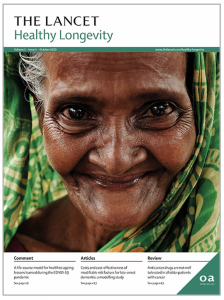New Lancet longevity commentary urges us to examine how we’ve treated an aging population during the pandemic
In the inaugural Lancet Healthy Longevity, lead Author Ashley Jowell, a second year medical student, and her coauthors examine strategies from around the world to improve well-being in our aging populations, applying lessons from the pandemic to ordinary life.
The COVID-19 pandemic has had a monumental impact on daily life across the world, with a disproportionate burden falling on people older than 65 years. Amidst this pandemic, we are living through a demographic transition with a rapidly aging global population.
The vulnerabilities that an aging population face during COVID-19 highlight the urgency of re-structuring our society to accommodate this growing proportion of our global community.
Increased mortality, isolation, food insecurity, and financial instability may have increased during the pandemic, but they are not new factors, only more pronounced in these circumstances. I was fortunate to get to collaborate with Dr. Michele Barry and Dr. Laura Carstensen on this piece to explore how societies can respond to the COVID-19 pandemic to cultivate longevity across the life-course.
In this commentary, “A life-course model for healthier ageing: lessons learned during the COVID-19 pandemic” published today in the first issue of the Lancet Healthy Longevity, we urge societies to adopt principles from the New Map of Life in order to respond with resilience to the COVID-19 pandemic.
“In low-and-middle-income countries, the dual burden of limited resources and increasing non-communicable diseases makes healthy aging difficult but now with COVID 19 successful aging has become even more challenging” said Dr. Michele Barry, coauthor of the commentary and Director of the Stanford Center for Innovation in Global Health. “We describe a new map of life for successful aging using principles applicable even during the pandemic”
Born out of Stanford Center on Longevity, the New Map of Life has identified six principles to guide long-lived societies. The New Map of Life applies to individuals of all ages, as it enables people to cultivate more meaningful lives throughout the life-course. These principles were shaped by the 2019 convening, “Global Agenda for a New Map of Life— Preparing the World for Longer, Healthier and More Fulfilled Lives” in Bellagio, Italy which Dr. Carstensen, Dr. Barry, and I all attended.
In this piece, we explore lessons learned from COVID-19 about each principle in the New Map of Life, and urge readers to learn from these lessons in order to integrate the New Map of Life into their daily lives. We also discuss strategies individuals and societies have adopted in line with the New Map of Life to respond to COVID-19 in both high income countries as well as low income and middle income countries. Applying these New Map of Life principles to pandemic and crisis response can cultivate a more resilient world for life during, and after, the pandemic.
Adoption of these lessons and principles is more critical now than ever before as we respond to this devastating pandemic, and consider how to re-build communities that enable people of all ages to live meaningful lives with purpose, belonging, and worth.
This comment piece was written in collaboration between Dr. Michele Barry, the Director of the Stanford Center for Innovation in Global Health, Dr. Laura Carstensen, the Director of Stanford Center on Longevity, and Ashley Jowell, a second year Stanford medical student.
Comment pieces are written by experts in the field, and represent their own views, rather than necessarily the views of The Lancet or any Lancet specialty journal. Unlike articles containing original research, this comment was not externally peer reviewed.

